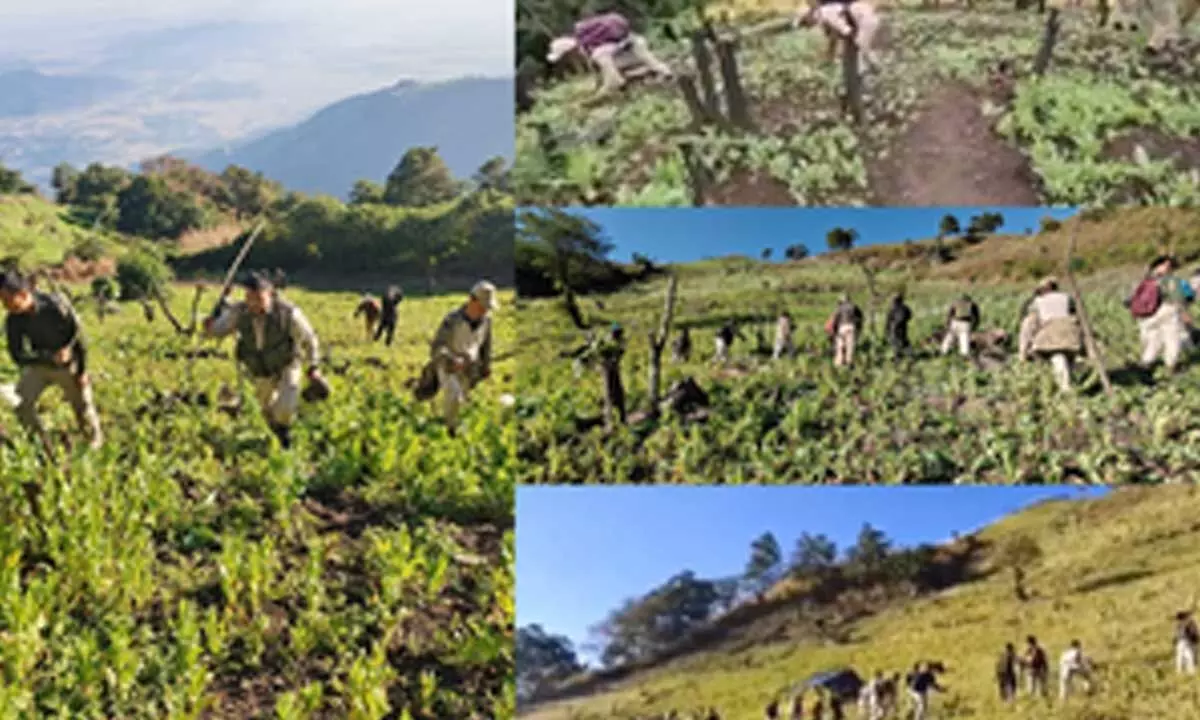Live
- APSRTC to Run 2,153 Special Buses for Sankranti Festival Rush
- HMPV Outbreak in India: Symptoms, Treatment, Health Insurance Coverage Explained
- Barracuda highlights evolving phishing techniques to look out for in 2025
- Disruptive Politics a Threat to Democracy, Warns Vice President Dhankhar
- Celebrating the planet’s daily spin
- Sandeshkhali gang-rape case: Woman pleas Calcutta HC, says police slow in probe
- Career in gaming: Opportunities, growth, and future
- Fight HMPV with hydration & nutrition, no antibiotics needed: Dr Randeep Guleria
- Satya Nadella announces $3 billion investment to boost AI, cloud infrastructure in India
- Delhi election dates: Voting on Feb 5, results on Feb 8
Just In
Over 19,135 acres of poppy cultivation destroyed in seven years: Manipur govt report

Various law enforcing agencies, including Manipur Police, have destroyed 19,135.60 acres of illegal poppy cultivation in the state’s 12 districts between 2017 and 2024, an official report said on Monday.
Imphal: Various law enforcing agencies, including Manipur Police, have destroyed 19,135.60 acres of illegal poppy cultivation in the state’s 12 districts between 2017 and 2024, an official report said on Monday.
According to the report, prepared by Manipur Remote Sensing Applications Centre (MARSAC), in the mountainous Kangpokpi district, the highest areas of 4,454.4 acres of illegal poppy cultivation were destroyed in the last seven years (2017-2024), followed by 3,348 acres in Ukhrul and 2,713.8 acres in Churachandpur. The MARSAC is an autonomous government institution under the Planning Department, Government of Manipur.
The other districts where illicit poppy farming areas were destroyed during this period include 2,575 acres in Tengnoupal, 1,982.5 acres in Chandel, 1,682 acres in Senapati and 737.9 acres in Imphal East districts.
The 12 districts out of the state’s 16 districts are mostly in mountainous areas.
According to the report, of the 19,135.60 acres, illegal poppy cultivation was destroyed mostly in 2020-21 (4,652 acres) and 2022-23 (4,305.10 acres).
The report, accessed by IANS, said the area under illegal poppy cultivation in nine districts -- Chandel, Churachandpur, Kamjong, Kangpokpi, Noney, Senapati, Tamenglong, Tengnoupal, Ukhrul -- in 2021-22 was 28,598.91 acres, which declined to 11,288.1 acres in 2023-24.
Overall in 2023-2024, opium poppy cultivation in the state decreased by 32.13 per cent compared to the previous year of 2022-2023, the report said, adding that a total of over 11,288.07 acres of opium poppy cultivation took place in Manipur in 2023-2024.
There was a decline of 60 per cent of acreage under illicit poppy cultivation between 2021 and 2023.
The report said that as per action taken after the Anti-Narcotic Task Force’s first meeting held on March 29, 2022, the MARSAC has been conducting an annual monitoring of opium poppy cultivation areas in most districts of Manipur using Global Positioning System (GPS) and Remote Sensing technologies.
Deforestation, due to mass poppy cultivation, resulted in several adverse impacts on the ecosystem, including soil erosion, a loss of biodiversity, and changes in the local climate, the report said.
Another Manipur government report said that during the period from 2017 till date, the state government launched the ‘War on Drugs’ and seized or destroyed drugs worth Rs 60,000 crore in the international market.
These drugs include 304 kg of heroin powder, 3775 kg of brown sugar, 1804 kg of opium, 1976 kg of Yaba tablets and 422 kg of SP tablets, ice crystal and pseudoephedrine.
The Manipur government last week said that the ongoing ethnic strife in Manipur (since May last year) is a creation of illegal immigrants from Myanmar adding that these migrants after illegally settling in the state started the cultivation of illicit poppies.
Chief Minister N. Biren Singh’s ‘War on Drugs’ has strongly hit the illegal immigrants’ illegal activities, a government statement said.
According to the statement, since 1969, there has been an increase in the number of villages in the districts of Kangpokpi, Tengnoupal, Chandel, Churachandpur and Pherzawl by 893, from 731 to 1,624.
In the remaining hill districts of Tamenglong, Noney, Senapati, Ukhrul and Kamjong, which are Naga-dominated, the increase during the same period is a figure of merely 49, up from 527 to 576, a mere 9 per cent increase.
“Abnormal 122 per cent increase in mushrooming of villages, many of which are in forest areas, in the five hill districts, which are Kuki people dominated, or which have a sizeable Kuki population,” the government statement said.

© 2024 Hyderabad Media House Limited/The Hans India. All rights reserved. Powered by hocalwire.com






